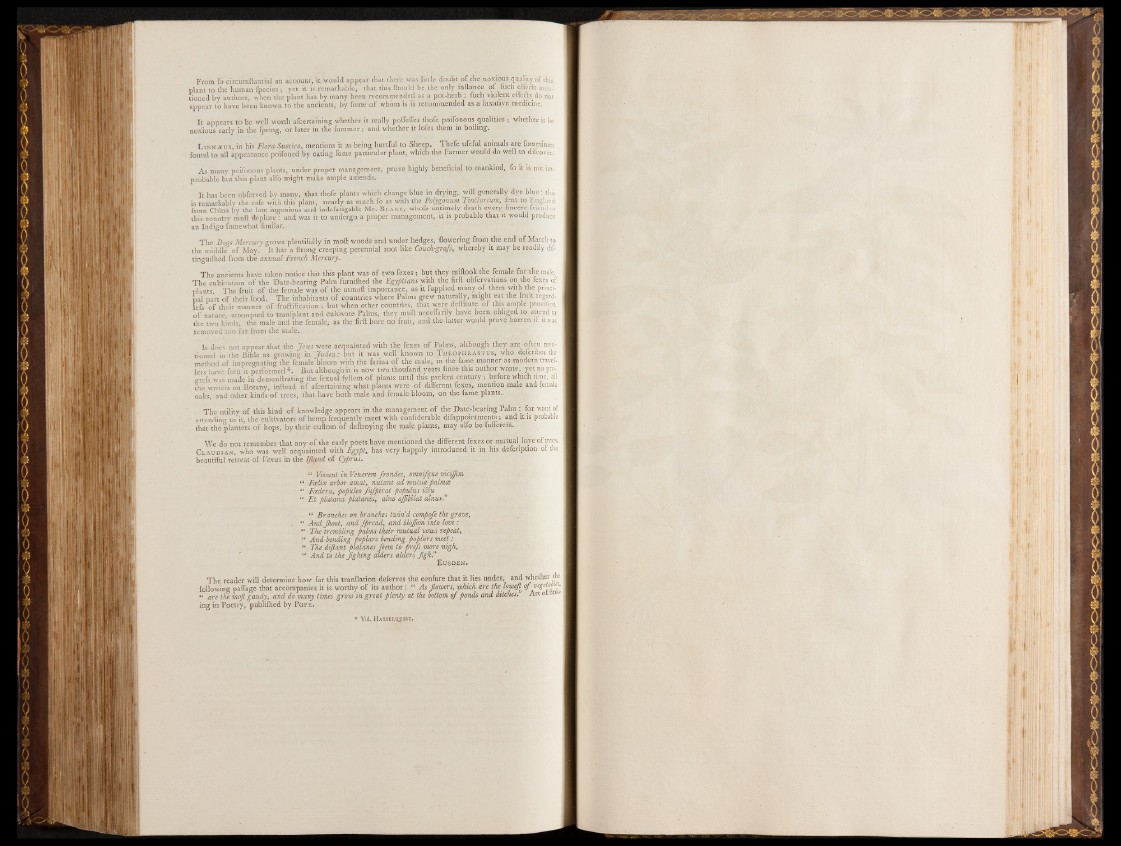
From fo circumflantial an account, it would appear that there was little doubt of the noxious quality of this
plant to the human fpecies ; yet it is remarkable, that this fhould be the only inftance of fuch effects mentioned
by authors, when the plant has by many been recommended as a pot-herb : fuch violent effe&s do not
appear to have been known to the ancients, by fome of whom is is recommended as a laxative medicine.
It appears to be well worth afcertaining whether it really pofleUes thofe poifonous qualities ; whether it be
noxious early in the fpring, or later in the fummer; and whether it lofes them in boiling.
L innaeus, in his Flora Suecica, mentions it as being hurtful to Sheep. Thefe ufeful animals are fometimes
found to all appearance poifoned by eating fome particular plant, which the Farmer would do well to difcover.
As many poifonous plants, under proper management, prove highly beneficial to mankind, fo it is not improbable
but this plant alfo might make ample amends.
It has been obferved by many, that thofe plants which change blue in drying, will generally dye blue : this
is remarkably the cafe with this plant, nearly as much fo as with the Polygonum Tmttonum, lent to England
from China by the late ingenious and indefatigable Mr. B l a k e , whofe untimely death every fincere: friend to
this country muft deplore : and was it to undergo a proper management, it is probable that it would produce
an Indigo fomewhat fimilar.
The Dogs Mercury grows plentifully in moft woods and under hedges, flowering from the end of March to
the middle of May. It has a ftrong creeping perennial root like Couch-grafs, whereby it may be readily dil-
tinguifhed from the annual French Mercury. ~
The ancients have taken notice that this plant was o f two fexes ; but they miflook the female for the male.
The cultivation of the Date-bearing Palm furnifhed the Egyptians with the firft obfervations on the fexes of
plants The fruit of the female was of the utmoft importance, as it fupplied many of them with the principal
part of their food. The inhabitants of countries where Palms grew naturally, might eat the fruit regard-
fefs of their manner of fruftification ; but when other countries, that were deftitute o f this ample provifion
of nature, attempted .to tranfplant and cultivate Palms, they muft neceffanly have been obliged to, attend to
the two kinds, the male and the female, as the firft bore no fruit, and the latter would prove barren ll it was
removed too far from the male.
It does not appear that the Jews were acquainted with the fexes of Palms, although they are often men-
tioned in the Bible as growing in Juiea: but it was well known to T h eophra stus , who defcnbcs the
method of impregnating the'female bloom with the farina of the male, m the fame manner as modern travellers
have feen it performed *. But although it is now two thoufand years lince this author wrote, yet no pro-
grefs was made in demonftrating the fexual fyflem of plants until this prefent century ; before which time, all
the writers on Botany, inftead of afcertaining what plants were of different fexes, mention male and temale
oaks, and other kinds o f trees, -that have both male and female bloom, on the fame plants.
The utility of this kind of knowledge appears in the management o f the Date-bearing Palm : for want of
attending to it, the cultivators of hemp frequently meet with confiderable difappointments; and it is probable
that the planters of hops, by their cuftom of deftroying the male plants, may alfo be fufferers.
We do not remember that any o f the early poets have mentioned the different fexes or mutual love of trees.
C l a u d ia n , who was well acquainted with Egypt, has very happily introduced it in his deicription ot the
beautiful retreat of Venus in the IJland of Cyprus.
“ Vivunt in Venerem frondes, omnifque viciffim
“ Fcdix arbor amat, nutant ad mutua palmas
“ Feeder a, populeo fufpirat populus i£tu
“ Et platana platanis, alno a/Jibilat alnus."
“ Branches on branches twin'd compofe the grove,
. “ And Jhoot, and fpread, and blojfom into love:
“ The trembling palms their mutual vows repeat,
“ And bending poplars bending poplars meet:
“ The diftant platanes feem to prefs more nigh,
And to the Jighing alders aiders Jigh."
E u s d en .
The reader will determine how far this tranflation deferves the cenfure that it lies under, and whether the ;
following paflage that accompanies it is worthy of its author : “ As flowers, which are the lowejl^ of ttfgc >
« are the mojl gaudy, and do many times grow in great plenty at the bottom o f ponds and ditches. Art or m
ing in Poetry, publilhed by Pope.
Vid. Hasseiqjjist.